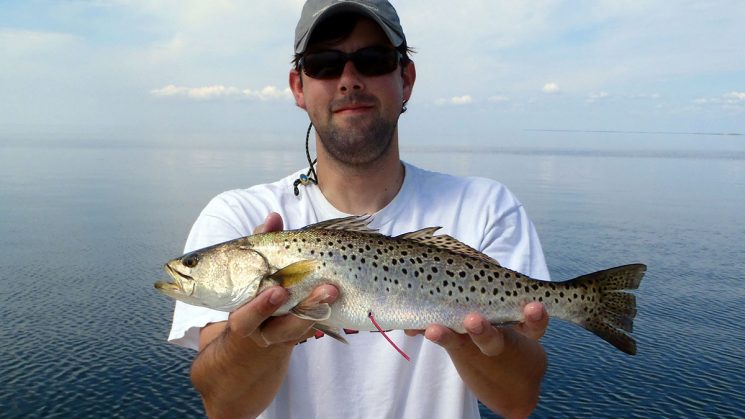
The following research was supported by North Carolina Sea Grant and the N.C. Coastal Recreational Fishing License Fund. This piece originally appeared on NC State University’s news page. Contact author Matt Shipman at matt_shipman@ncsu.edu or 919-515-6386.
Cold winter weather can play a key role in what you’re allowed to fish for next spring. That point was driven home when low temperatures in early January led North Carolina to temporarily bar fishing for spotted seatrout (Cynoscion nebulosus), one of the most popular targets for recreational anglers.
Stories about isolated fish kills resulting from cold temperatures — or “cold stuns” — of spotted seatrout date back more than 100 years. But no one knew just how important these events could be until 2017, when NC State researchers published new findings on population impacts.
“We had a lot of anecdotes about spotted seatrout, but in order to make good fishery management decisions, you need quantifiable, scientific data,” says Tim Ellis, now an ecosystems analyst for the Albemarle-Pamlico National Estuary Partnership who did research on cold stuns and spotted seatrout while a Ph.D. student at NC State.
Ellis, in collaboration with Joe Hightower and Jeff Buckel of NC State, collected data on the spotted seatrout fisheries in North Carolina and Virginia from 2008 through 2014 – work that ultimately led to three publications in 2017 and 2018 that address the impact low temperatures can have on the species. And that impact can be significant.
“The full extent of this month’s cold stun is not yet known, but conditions seemed comparable to what we saw in 2010 – and that year’s cold temperatures led to around 95 percent mortality in spotted seatrout populations in North Carolina and Virginia,” Ellis says.
That’s a big deal, because spotted seatrout are one of the most sought-after species by recreational anglers in North Carolina – and throughout the southeastern U.S.
“In terms of dollars and cents, the N.C. Division of Marine Fisheries estimates that the recreational fishery for spotted seatrout in North Carolina alone, had a total economic impact of more than $54 million in 2016,” Ellis says.
The importance of this fishery, and the NC State findings, are likely why the N.C. Division of Marine Fisheries announced Jan. 5 that it was barring commercial and recreational fishing of spotted seatrout in North Carolina waters until June 15 – after the species has passed its peak spawning season.
Most spotted seatrout overwinter in shallow, estuarine waters, where water temperatures are strongly affected by the air temperature. That makes the species particularly susceptible to cold snaps like those we saw in the first weeks of 2018.
“In mild winters, spotted seatrout populations can thrive in North Carolina waters,” Ellis says. “But high mortality during cold winters means it could take a while for the fishery to rebound. The fishery is being closed in North Carolina to protect the remaining spawners, in hopes that this will help the species bounce back more quickly.”
“Until Tim decided to take a look, nobody knew how important cold temperatures could be for spotted seatrout at the population level,” Buckel says.
“Ultimately, our research is making a difference,” say Ellis, who also is a past Sea Grant/DMF Marine Fisheries Fellow.
“We gave fishery managers key information they needed to make informed decisions about how to respond to cold-stun events.”
The three relevant papers are “Relating cold tolerance to winterkill for spotted seatrout at its northern latitudinal limits,” published February 2017 in the Journal of Experimental Marine Biology and Ecology; “Winter severity influences spotted seatrout mortality in a southeast US estuarine system,” published February 2017 in the journal Marine Ecology Progress Series; and “Relative importance of fishing and natural mortality for spotted seatrout (Cynoscion nebulosus) estimated from a tag-return model and corroborated with survey data,” published in January 2018 by the journal Fisheries Research.